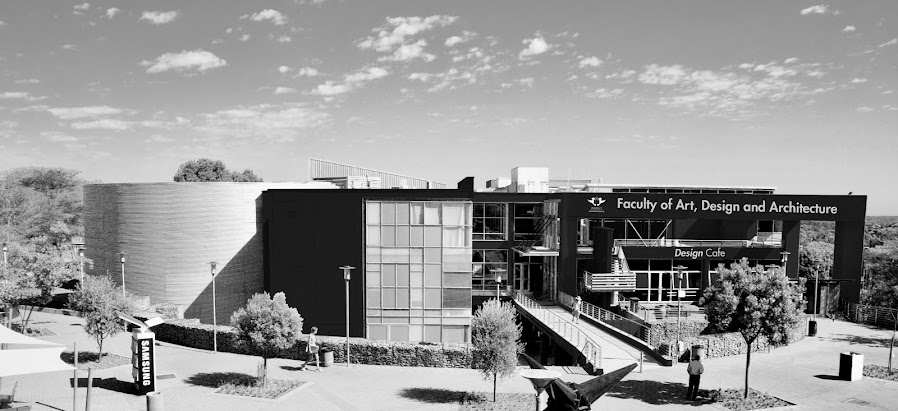eye hand mind
seeing making and
understanding
Learning departs from what is known. On the journey
documented here, words spoken by particular master weavers, beadwork makers, potters and painters, each situated in a particular cultural landscape, are leading to successful learning ideas for the rural high school.
Official Event:
Monday 20 July 18:00 for 18:30.
Daily viewing from
Monday 13 July – Friday 24 July 2015.
Gallery hours:
Monday to Friday 09:00 – 16:00.
‘It’s been here all along!’ exclaimed a
Mathematics teacher, beading needle in hand, as she looked closely at the
sophisticated geometric pattern of a beaded ubeshwana
- a traditional beaded Zulu apron. ‘Why didn’t we see it before?’
 |
| Beauty Ngxongo. Finely crafted Izichumo (zulu basket) Penny and Digby Hoets Collection. |
Much is written about South Africa’s education crisis.
But seldom does one read about the needs of rural teachers and learners. Their
learning context is very different to the urban one due to a lack of resources
we take for granted. The South African rural learning ecology, situated in more than one ‘cultural heartland’ (as the
road signs signal on the N12 north-east, for
example) is seldom considered for
what it might have to offer the South African high school learner.
 |
| Beauty Ngxongo. Finely crafted Izichumo (zulu basket) Penny and Digby Hoets Collection. |
The exhibition Eye hand mind: seeing, making and understanding, was curated by Eugene Hön and Helene Smuts to celebrate the work of rural master artists, national treasures all, as the expression of southern Africa’s relatively unacknowledged local knowledge systems.
 |
| Nesta Nala, Masterfully crafted uphiso, coiled and pit-fired Zulu ceramic vessel. |
 |
| Zulu beaded waistcoat. |
The exhibition also presents an extraordinary process of rural/urban knowledge exchange. The Africa meets Africa project (AmA), an independent educational NPC (Non Profit Company) has been facilitating this knowledge exchange in an ongoing conversation with artists and local leadership in particular rural communities and the AmA interdisciplinary team of foremost academic specialists.
 |
| Nthombifuthi Magwaza. Telephone wire woven basket. Gold award winner FNB Crafts Now 1998. UJ Collection. |
 |
| Reuben Ndwandwe woven baskets. Collections Jannie van Heerden and UJ. |
This primary research is published in a richly illustrated series of educator’s resource books and narrative documentary films (on sale at the exhibition, along with remarkable pieces of traditional beadwork, weaving and painting) which certainly open up the rural heartland for any one of us South Africans who seldom escape urban life.Edited versions of the films, produced by Guy Spiller (Art, science and heritage filmmaker), together with ceramic vessels and art works are showcased in the black-cube, the lower-ground floor of the FADA Gallery (image below).
 |
| Ndebele beadwork, aprons on display. Collection Alex Zaloumis. |
Out of its research Africa
meets Africa has developed pragmatic solutions for the rural and urban South
African classroom both, by looking to the broad diversity of interlinked
southern African local knowledge systems, particularly as these are articulated
in the skilled hands of rural artists. Exquisite objects, made for everyday use
according to inherited styles of beadwork, weaving, pottery and homestead
painting, reveal an astonishing integrity of design and innovation with
contemporary materials and forms.
Now Grade 9 and 10 teachers and learners make beadwork, weave and paint to find a concrete and a visual entry point to the abstract language of mathematics. Science is introduced through contemporary cutting edge South African art, astronomy and archeology and the act of sensitive observation these disciplines have in common.
Now Grade 9 and 10 teachers and learners make beadwork, weave and paint to find a concrete and a visual entry point to the abstract language of mathematics. Science is introduced through contemporary cutting edge South African art, astronomy and archeology and the act of sensitive observation these disciplines have in common.
And yet: the surviving
iconic master artists of rural South Africa, like the famous Esther Mahlangu (image below), a
key participant in the project, share great concern that their art might not
survive beyond their own generation.
 |
| Francinah Ndimande. Photo Helene Smuts. |
The exhibition Eye hand mind: seeing, making and
understanding also shows how Africa meets Africa brings these master
artists and their knowledge into the rural classroom. AmA has developed a
unique arts skills based learning methodology, which integrates the subjects
Visual arts, History and Mathematics within the requirements of the national
CAPS curriculum. High school learners do geometry with their hands as they make
beadwork and weave according to inherited southern African styles.
 |
| Francinah Ndimande painting her homestead. Photo Helene Smuts. copyright photographer. |
Asked how she manages to paint straight lines
by hand and why her complex patterns work out so perfectly, Ndebele artist, the
late Francinah Ndimande answered: ‘ I use my eye only’. (image below)
The famous Mathematician Bênoit Mandelbrot wrote in his The Fractal Geometry of Nature published
in 1982:
‘For me the eye is the most sophisticated
instrument of thought. It sees similarities before a formula has been created
to identify them’.
About Africa meets Africa.
Africa meets Africa
introduces teachers to all its CAPS curriculum linked resource materials within
training programmes presented in partnership with various universities and
provincial or district government education departments. Ultimately each
teacher works with the full series of Africa meets Africa resources developed
in relation to particular places within a shared southern African cultural
landscape. Each resource book and film in the Africa meets Africa series is on
display in the exhibition: Eye hand mind: seeing, making and
understanding along with some of the exquisite examples of southern
African art which inspired them.
For
additional information on Africa meets Africa, view the Website: or contact the director Helene Smuts
(Director).
Email: helenesmuts@gmail.com.
A wide range of works are for sale - price-list available on request.
























